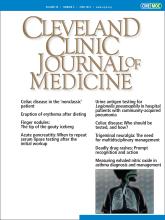Article Figures & Data
Tables
Key symptoms Other possible symptoms Differential diagnosis Paroxysmal pain
Sharp and shooting
Lasts seconds to minutes
Provoked by light touch
Burning, prickling, dull tender constant background pain Trigeminal neuralgia with concomitant, continuous pain Trigeminal nerve innervation area Interparoxysmal pain Temporomandibular disorder Pain cannot be evoked between attacks (refractory period) Autonomic symptomsa SUNCT and SUNA Periods of remission or relapse Sensory changeb Painful trigeminal neuropathy Abrupt onset After eating Dental, cracked tooth ↵a Some facial reddening and tearing, sometimes on both sides, may be seen during acute pain paroxysms. If more pronounced with strictly unilateral conjunctival reddening, eyelid droop, nasal blockage, then consider SUNCT and SUNA.
↵b During a relapse of trigeminal neuralgia and especially just after paroxysms of pain, there may be subtle transient unilateral sensory change in the area innervated by the trigeminal nerve. The presence of permanent sensory alterations and atypical features such as absent refractory period and no pain remission raise the possibility of trigeminal nerve damage and painful trigeminal neuropathy.
SUNA = short-lasting unilateral neuralgiform headache attacks with autonomic features; SUNCT = short-lasting unilateral neuralgiform headache attacks with conjunctival injection and tearing
Type Subtypes Classic trigeminal neuralgia (neurovascular compression present) Purely paroxysmal
Concomitant continuous pain
Secondary trigeminal neuralgia (underlying pathology present) Attributed to multiple sclerosis
Attributed to space-occupying lesion
Atributed to other causes
Idiopathic trigeminal neuralgia (no underlying cause found) Purely paroxysmal
Concomitant continuous pain
Based on data from reference 4.
Drug Dosage regimen Usual dose range Common side effects First-line therapy Carbamazepinea 100 mg twice daily; double after 3 days to 200 mg twice daily; increase by 100–200 mg twice daily every 3 days, then 200 mg 4 times daily 800–1,200 mg daily Sedation, dizziness, blurred vision, nausea, unsteady lethargy, double vision, headache
May cause hyponatremia, skin rashes, pancytopenia
Risk of osteoporosis with long-term use
May reduce oral contraception efficacyOxcarbazepinea 150 mg twice daily, double to 300 mg twice daily after 3 days; increase by 150–300 mg twice daily every 3 days, then 300 mg 4 times daily 1,200–1,800 mg daily Drowsiness, dizziness, diplopia, confusion, nausea, abdominal pain, headache, depression, diarrhea
High risk of hyponatremia
Chronic use risks osteoporosis
May reduce oral contraception efficacySecond-line therapy Lamotrigine Start 25 mg a day for 7 days, then 25 mg twice daily for 7 days, then 50 mg twice daily for another week; subsequent dose increments of 50 mg every 7 days, up to 10 weeks 200 mg twice daily Blurred vision, agitation, aggression, unsteadiness, dizziness, nausea, dry mouth, insomnia, joint pains
Risk of skin rashes and Stevens-Johnson syndrome with rapid dose escalation
Probably safe for pregnant women at a dose of 100 mg twice dailyBaclofen 5 mg 3 times daily for 3 days, then increase to 10 mg 3 times daily for 3 days; increase by 10 mg 3 times daily every 3 days until maximum dose 40–80 mg daily Anxiety, depression, agitation, unsteadiness, headache, sedation, tremor, skin rash, blurred vision, dry mouth, abdominal pain, withdrawal symptoms if stopped too rapidly Gabapentin 100 mg 3 times daily day 1, 200 mg 3 times daily day 2 and 300 mg 3 times daily day 3. Increase by 1-300 mg 3 times daily every 3 days to maximum dose; start 100 mg 3 times daily or 300 mg at bedtime; can increase dose up to 300 to 600 mg 3 daily 900–3,600 mg daily Amnesia, confusion, dizziness, vertigo, drowsiness, depression, nausea, blurred vision, peripheral edema, constipation, abdominal bloating, weight gain Pregabalin 25 mg twice daily; increase by 25–50 mg twice daily every 3 days 600 mg daily Confusion, drowsiness, constipation, blurred vision, dizziness, nausea, peripheral edema, increased appetite, weight gain ↵a Carbamazepine and oxcarbazepine are available in liquid form. Dosage ranges vary due to lack of high-quality trials.
- TABLE 4
Treatments for acute episodes of trigeminal neuralgia based on a systematic review
Provider Treatment All clinicians (dentist, general practitioner, specialist) Lidocaine
10-mg nasal spray, 2 sprays into nostril on affected side; can be used intraorally, but spit out after 1 minute
5% ointment to trigger area
2% 1:80,000 adrenaline local infiltration to nerve block trigger area
General practitioner, specialist Sumatriptan 6 mg subcutaneous injection, followed by oral sumatriptan 50 mg twice daily for 1 week Specialist only Botulinum toxin type A injection, 3 mg in 1 mL Specialist, inpatient basis Intravenous Infusions
Lidocaine 1.5 mg/kg over 1 hour, up to 5 mg/kg in a randomized clinical trial
Phenytoin 10 mg/kg
Fosphenytoin 15 mg/kg
Based on data from references 9 and 11.






